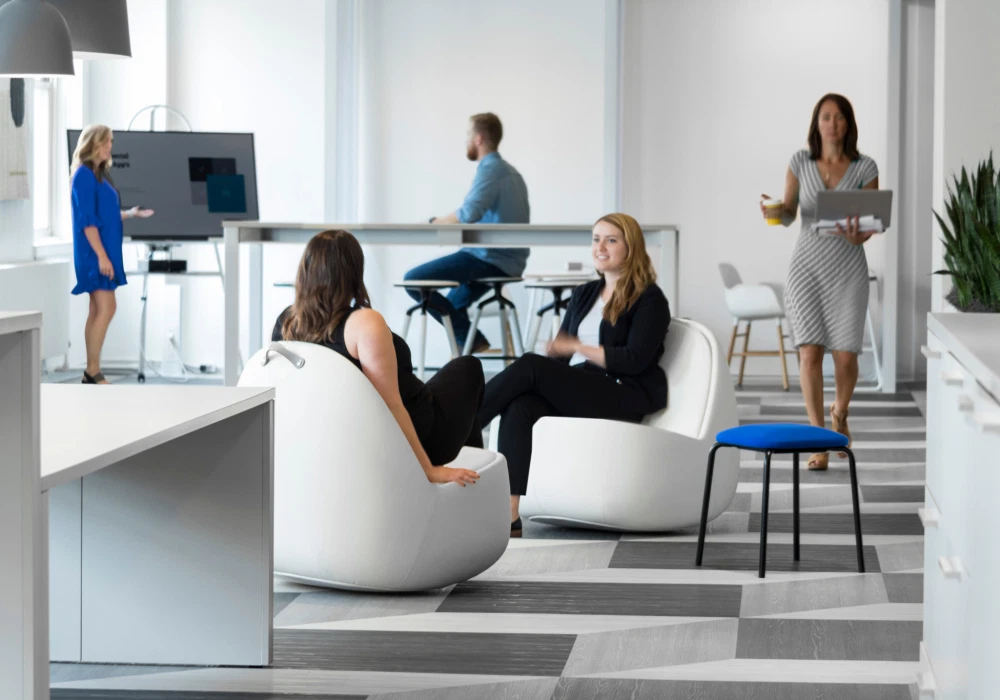3 Tips to Help You Reach Your Employee Recruitment and Retention Goals
The shortage of qualified candidates to fill job vacancies in our current economy means that finding and keeping talented individuals who share our companies’ values can be difficult.
Of course, there are a lot of factors that affect how well a company recruits and retains qualified employees, and some of them are harder to address or improve than others. But, thankfully, there are some things we can all easily do to make the culture of our companies more appealing to current and prospective employees, and they have to do with changes to the built environment. Here are three questions you can ask that may help you improve both the atmosphere of your workplace environment and your recruitment and retention numbers.
1. How Does It Look?

Tip number one is pay close attention to aesthetics. Is your workplace visually appealing? Is it inviting to both employees and clients? Something as simple as adding some locally-crafted artwork to the walls or creating a comfortable, beautiful small touchdown space in an underused part of the office can go a long way in making your workplace more comfortable for employees, and can also help increase creativity, productivity, and overall satisfaction.
Consider forming a diverse employee team from different departments and positions across your organization to develop and implement a plan to improve the aesthetics of your space with recruitment, retention, and employee satisfaction in mind. Give them a budget for the improvements and freedom to make decisions. You’ll get better buy-in from your employees, ensure that you’re creating something that your employees and prospective employees will like, and increase morale in the workplace by demonstrating your care and concern for employee well-being and your value and respect for their needs, perspectives, and abilities.
2. How Does It Feel?

One of the things employees and prospective employees are looking for in an employer is how well the employer cares for the overall well-being of its staff and clients. One way to demonstrate this concern for well-being and help reduce workers’ compensation costs and missed workdays is to pay attention to ergonomics. Are your employees able to work comfortably throughout the day, without any workplace injury issues like back pain, carpal tunnel, eye strain, etc.? Are they encouraged to get up and move around the workplace during the day for optimum health? Do they know how to adjust their office furniture so it fits them? If you’re not sure how to create an ergonomically-friendly work environment, check out some of the ergonomics resources on our Benjamin Roberts website, HERE.
3. How Does It Sound?

The third and final tip is to address acoustics in the built environment. With the move towards more open office environments comes greater opportunities for collaboration and transparency, which builds trust. Unfortunately, it can also mean an increase in volume and distractions, as well as a sense of lost privacy and ability to focus. One easy way to address sound concerns is to install acoustical panels. These panels are designed to help control volume levels and can add fun, interesting, contemporary design elements and color to your workplace. There are many options and price points available when it comes to incorporating acoustical panels into the built environment. If you’re interested in learning more about acoustical panels, contact our team at 717-291-1001, or send us an EMAIL.
Creating a built environment that supports and reflects your company’s culture can go a long way in helping you achieve your recruitment and retention goals. By considering aesthetics, ergonomics, and acoustics, you can greatly improve the appeal of your workplace while also helping to reduce costs and maintain a team of highly qualified employees whose personal values match your company’s values and who can help you exceed your organization’s goals.
Here’s to creating places that inspire, empower, and equip your employees and your company for success!
Learn more about Benjamin Roberts Office Interiors, HERE.
CollaborationCreate ArtCultureErgonomicsOffice DesignOffice FurniturePurposeValues
